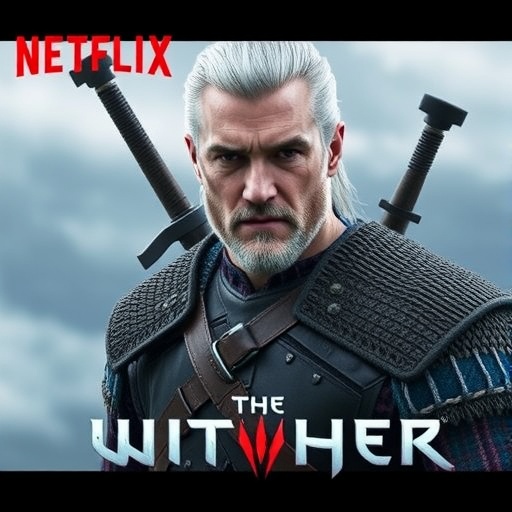The Witcher Season 4 Release Date Revealed: Liam Hemsworth Debuts as Geralt on Netflix October 2025
In a move that’s sending shockwaves through the fantasy community, Netflix has officially announced that The Witcher Season 4 will premiere on October 30, 2025, marking the highly anticipated debut of Liam Hemsworth as the iconic monster hunter Geralt of Rivia. Fans have been on the edge of their seats since Henry Cavill’s dramatic exit after Season 3, and this new chapter promises to plunge the Continent into deeper turmoil as war scatters its heroes, forcing unlikely alliances to form amid the chaos.
- Liam Hemsworth Steps Up: From Hunger Games to the White Wolf
- War-Torn Continent: How Season 4 Splits the Core Trio
- Forging New Bonds: Introducing Allies and Antagonists in the Fray
- Production Hurdles Overcome: Netflix’s Commitment to Fantasy Epic
- Global Fan Frenzy and the Road Ahead for The Witcher’s Legacy
The announcement, dropped during Netflix’s Tudum global fan event, comes with a teaser that hints at epic battles, political intrigue, and the emotional toll of separation on beloved characters like Yennefer, Ciri, and Geralt himself. With the fantasy genre booming—Netflix’s fantasy titles garnered over 1.2 billion hours of viewership in 2023 alone—this season could solidify The Witcher as a cornerstone of the streamer’s original content slate.
Liam Hemsworth Steps Up: From Hunger Games to the White Wolf
Liam Hemsworth’s casting as Geralt has been one of the most talked-about transitions in recent TV history. The Australian actor, best known for his role as Gale Hawthorne in the Hunger Games franchise, brings a fresh intensity to the witcher who walks a fine line between man and monster. At 35 years old, Hemsworth’s rugged physique and brooding screen presence make him a natural fit for the character drawn from Andrzej Sapkowski’s beloved book series.
“Taking on Geralt is both an honor and a challenge,” Hemsworth shared in an exclusive interview with Variety at the Tudum event. “Henry Cavill set an incredible bar, but I’m excited to bring my own interpretation to this world of magic and moral ambiguity.” Sources close to production reveal that Hemsworth underwent rigorous training, including sword fighting sessions with the same stunt coordinator from Seasons 1-3, to capture Geralt’s signature cat-like grace and lethal precision.
The recasting wasn’t without controversy. When Cavill announced his departure in October 2022, citing creative differences over the show’s adaptation of the source material, social media erupted. A Change.org petition to bring him back amassed over 300,000 signatures. Yet, Netflix stood firm, and Hemsworth’s first-look images—showing him in the witcher’s scarred face and medallion—have begun to sway skeptics. Early test screenings reportedly praised his chemistry with co-stars Anya Chalotra (Yennefer) and Freya Allan (Ciri), suggesting the transition could breathe new life into the series.
Statistically, the stakes are high. The Witcher Season 1 drew 541 million minutes viewed in its debut week, per Nielsen data, and subsequent seasons maintained strong numbers despite mixed reviews. Hemsworth’s star power, bolstered by his 10 million Instagram followers, is expected to boost global reach, particularly in markets like Australia and the U.S. where his films have performed well.
War-Torn Continent: How Season 4 Splits the Core Trio
Season 4 of The Witcher dives headfirst into the escalating conflicts that defined Andrzej Sapkowski’s novels, with war ripping apart the fragile bonds between its protagonists. The official synopsis teases that Geralt, Yennefer, and Ciri are separated by the ravages of battle across the Continent, each facing personal demons while navigating a world on the brink of collapse. This narrative pivot builds directly on Season 3’s cliffhanger, where the Battle of Sodden loomed large and Ciri’s powers hinted at a destiny that could upend kingdoms.
Showrunner Lauren Schmidt Hissrich elaborated in a panel discussion: “The separation allows us to explore the characters in isolation, highlighting their growth and vulnerabilities. Geralt’s path will test his code as a witcher, Yennefer’s magic will face unprecedented threats, and Ciri’s journey into her Elder Blood heritage will reveal shocking alliances.” Filming, which wrapped principal photography in May 2024 after delays due to the 2023 writers’ strike, took place across Hungary, Poland, and the UK, capturing the gritty realism of a fantasy war zone.
Delving deeper into the lore, the season draws from “Time of Contempt” and “Baptism of Fire,” books that emphasize the Nilfgaardian Empire’s relentless expansion. Expect sprawling set pieces: sieges on fortified cities like Aretuza, ambushes in misty forests, and tense standoffs in war camps. Visual effects teams, led by Framestore (known for Game of Thrones), have amped up the spectacle, with over 1,500 VFX shots planned to depict dragons, portals, and monstrous foes.
Fans of the books will appreciate the faithful nods—such as Geralt’s encounters with the dryads of Brokilon or Yennefer’s dealings with elven insurgents—while newcomers can follow the streamlined plot. The separation motif isn’t just plot-driven; it’s a metaphor for the post-pandemic world, as Hissrich noted in a Hollywood Reporter interview, reflecting themes of isolation and reconnection that resonated in earlier seasons.
Forging New Bonds: Introducing Allies and Antagonists in the Fray
As the main characters scatter, Season 4 introduces a cadre of new allies and foes that could redefine the power dynamics on the Continent. Among the fresh faces is Michelle Yeoh as a enigmatic sorceress tied to the Lodge of Sorceresses, whose wisdom and ruthlessness promise to challenge Yennefer’s authority. Yeoh, fresh off her Oscar win for Everything Everywhere All at Once, brings gravitas to the role, with early buzz suggesting her character could become a fan favorite.
Other additions include Charlie Rowe as a cunning Nilfgaardian spy whose loyalties blur the lines between enemy and potential savior for Ciri, and a returning Joey Batey as the bard Jaskier, now entangled in espionage. “These new characters aren’t just fillers; they’re integral to the survival of our heroes,” Hissrich explained. The ensemble expands the fantasy tapestry, incorporating diverse cultures from the books—like the nomadic Scoia’tael elves and dwarven mercenaries—to enrich the world’s multiculturalism.
Antagonists get upgrades too. The White Flame, Emperor Emhyr var Emreis, sees expanded screen time with Mahesh Jadu in the role, plotting from his iron throne as his armies conquer the North. Leaked set photos show massive battle sequences involving thousands of extras, rivaling the scale of The Lord of the Rings. Production designer Andrew Laws revealed that sets for the imperial capital of Nilfgaard cost over $5 million, featuring towering spires and flame motifs that evoke dread.
This influx of characters aligns with Netflix’s strategy to broaden The Witcher‘s appeal. Spin-offs like The Witcher: Blood Origin (2022) and the animated The Witcher: Nightmare of the Wolf have already expanded the universe, amassing 142 million viewing hours combined. Season 4’s new blood could pave the way for crossovers, with Hissrich hinting at “shared mythology” in future projects.
Production Hurdles Overcome: Netflix’s Commitment to Fantasy Epic
Bringing Season 4 to life wasn’t without its trials. The recasting of Geralt delayed pre-production by six months, and the 2023 SAG-AFTRA strike halted filming for four months, pushing the budget to an estimated $12 million per episode—up 20% from Season 3. Yet, Netflix’s investment underscores their faith in the franchise. CEO Ted Sarandos has publicly stated that fantasy remains a priority, with The Witcher anchoring their 2025 slate alongside Avatar: The Last Airbender and Wednesday Season 2.
Director Jeremy Webb, who helmed key episodes in prior seasons, returns for the premiere, emphasizing practical effects over CGI where possible. “We wanted to ground the magic in the actors’ performances,” he said in a Deadline Q&A. Sound design, a hallmark of the series, features composer Sonya Belousova’s soaring scores, now infused with war drums and elven chants recorded with a 60-piece orchestra in Prague.
Behind-the-scenes anecdotes abound: Hemsworth bonded with the cast during a month-long boot camp in the Scottish Highlands, learning basic Polish phrases to honor the source material’s roots. Sustainability efforts included electric vehicles for transport and recycled materials for props, aligning with Netflix’s green initiatives. The global crew of 1,200, hailing from 20 countries, reflects the show’s international flavor, boosting local economies in filming locations.
Critically, the series has evolved. Rotten Tomatoes scores improved from 68% for Season 1 to 78% for Season 3, thanks to tighter storytelling. With Season 4, expectations are for a return to the gritty, monster-hunting roots that hooked 76 million households in the first month of release.
Global Fan Frenzy and the Road Ahead for The Witcher’s Legacy
The reveal of The Witcher Season 4‘s date has ignited a firestorm online, with #WitcherS4 trending worldwide and fan art flooding platforms like DeviantArt. Cosplay conventions from Comic-Con to Gamescom are already buzzing, and merchandise sales—swords, medallions, and novels—spiked 40% post-announcement, per CD Projekt Red data. Polish fans, proud of their cultural export, organized watch parties in Warsaw, while U.S. viewers petition for IMAX screenings.
Looking forward, the season sets up a potential fifth and final installment, adapting the saga’s climax from “The Lady of the Lake.” Netflix has greenlit scripting for Season 5, with Hissrich teasing a “grand convergence” of storylines. Expansions could include more animated shorts or a prequel on the Conjunction of the Spheres. For Liam Hemsworth, this role cements his pivot to leading man status, possibly opening doors to Marvel or DC.
As the Continent braces for war, The Witcher on Netflix stands poised to captivate a new generation of fantasy enthusiasts. With its blend of heart-pounding action, complex characters, and timely themes of resilience, Season 4 isn’t just a continuation—it’s a bold evolution that could redefine streaming epics for years to come.










